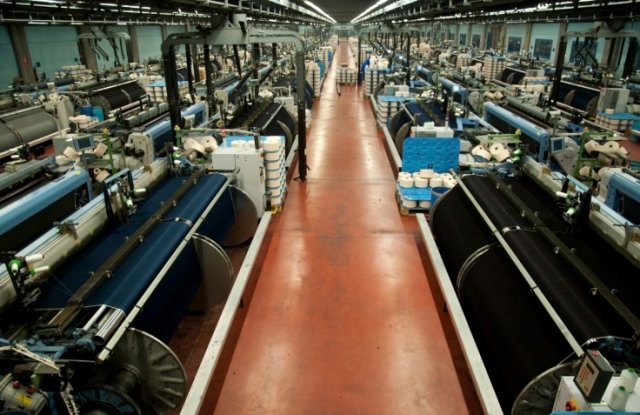Textile Mills Effluent Guidelines

The EPA promulgated the Textile Mills Effluent Guidelines (40 CFR Part 410) in 1974, and amended the regulation in 1977 and 1982. The regulation covers direct dischargerA point source that discharges pollutants to waters of the United States, such as streams, lakes, or oceans. facilities. The Textile Mills Effluent Guidelines are incorporated into NPDES permits.
On this page:
- What is the Textile Mills Industry?
- Pollutants and Subcategories
- Detailed PFAS Study
- Guidance
- Rulemaking History
- Additional Information
What is the Textile Mills Industry?
- receiving and preparing fibers
- transforming these materials into yarn, thread or webbing
- converting the yarn and webbing into fabric or related products; and
- finishing these materials.
Many facilities produce a final consumer product such as thread, yarn, bolt fabric, hosiery, towels, sheets and carpet, while the rest produce a transitional product for use by other establishments in the industry.
- wool scouring, topmaking, and general cleaning of raw wool
- wool finishing, including carbonizing, fulling, dyeing, bleaching, rinsing, fireproofing, and other similar processes
- yarn manufacture, unfinished fabric manufacture, fabric coating, fabric laminating, tire cord and fabric dipping, and carpet tufting and carpet backing
- woven fabric finishing, including desizing, bleaching, mercerizing, dyeing, printing, resin treatment, waterproofing, flameproofing, and application of soil repellency and other special finishes
- knit fabric finishing, including bleaching, mercerizing, dyeing, printing, resin treatment, waterproofing, flameproofing, and application of soil repellency and other special finishes
- carpet finishing, including bleaching, scouring, carbonizing, fulling, dyeing, printing, resin treatment, waterproofing, flameproofing, soil repellency, looping, and backing with foamed and unfoamed latex and jute
- stock and yarn finishing, including cleaning, scouring, bleaching, mercerizing, dyeing and special finishing
- manufacturing of nonwoven textile products of wool, cotton, or synthetics, or blends of such fabrics
Note: the NAICS listing is provided as a guide and does not define the coverage of the Textile Mills category. For precise definitions of coverage, see the applicability sections in 40 CFR Part 410.
Pollutants and Subcategories
Regulated Pollutants
Effluent limitations vary by subcategory.
- BOD5
- COD
- TSS
- Oil and grease
- Sulfide
- Phenols
- Total chromium
- pH
Regulation Subcategories
- Wool Scouring
- Wool Finishing
- Low Water Use Processing
- Woven Fabric Finishing
- Knit Fabric Finishing
- Carpet Finishing
- Stock and Yarn Finishing
- Nonwoven Manufacturing
- Felted Fabric Processing
Detailed PFAS Study
As announced in the Effluent Guidelines Program Plan 15 (January 2023), the EPA continued to evaluate the available data on types and concentrations of PFAS PFAS, Per- and polyfluoroalkyl substances (PFAS) are a group of synthetic chemicals that have been in use since the 1940s. PFAS are found in a wide array of consumer and industrial products. PFAS manufacturing and processing facilities, facilities using PFAS in production of other products, airports, and military installations are some of the potential contributors of PFAS releases into the air, soil, and water. Due to their widespread use and persistence in the environment, most people in the United States have been exposed to PFAS. There is evidence that continued exposure above specific levels to certain PFAS may lead to adverse health effects. in wastewater discharged from textile mills and intends to expand the detailed study of the Textile Mills Category to gather information on the use and treatment of PFAS in this industry and associated PFAS discharges.
The EPA has determined that PFAS have been and continue to be used by textile and carpet manufacturers. The Agency's review of PFAS use and discharge by the textile mills is largely based on publicly available information and literature. Based on a small number of sample results, the EPA determined that PFAS, including legacy long-chain PFAS, are present in wastewater discharges from some textile mills to POTWs. Most textile mills are not monitoring for PFAS, nor are they required to do so. Therefore, the EPA expects that textile mills may be discharging PFAS to POTWs or surface waters even when the textile mill no longer uses PFAS in their process.
There are limited publicly available data on textile mills, including potential use and discharge of PFAS, fluoropolymers, and fluorotelomers. As a result, the EPA will collect additional data to determine if the current regulations remain appropriate and, if warranted, to develop and propose new regulations.
Previous Industry Study
Guidance
- Industrial Stormwater Fact Sheet:
Sector V: Textile Mills, Apparel, and Other Fabric Product Manufacturing Facilities (December 2006) - Best Management Practices for Pollution Prevention in the Textile Industry Manual (pdf)
Rulemaking History
1983 Correction
1982 Amendment
- Textile Mills Effluent Guidelines - Final Rule (pdf)
- Textile Mills Effluent Guidelines - Notice of Availability (pdf)
- Textile Mills Effluent Guidelines - Proposed Rule (pdf)
1977 Amendment
- Textile Mills Effluent Guidelines - Final Rule (pdf)
- Textile Mills Effluent Guidelines - Proposed Rule (pdf)
1974 Initial Rulemaking
- Textile Mills Effluent Guidelines - Final Rule (pdf)
- Textile Mills Effluent Guidelines - Proposed Rule (pdf)
Additional Information
- For additional information about the draft questionnaire, please contact Paul Shriner (shriner.paul@epa.gov) at 202-566-1076.
- For information regarding the Textile Mills Effluent Guidelines regulation, please contact Anthony Tripp (tripp.anthony@epa.gov) at 202-566-1419.
